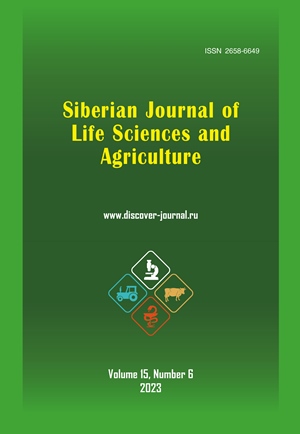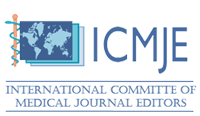CLIMATIC FACTORS CHARACTERIZING THE MOISTURE SUPPLY OF THE TERRITORY AND THEIR EFFECT ON THE QUALITY INDICATORS OF GRAPES
Abstract
The study of scientific problem, to which this research is devoted, is due to planetary climate change, manifested in an increase in the average annual air temperature, rapid changes in winter and summer temperatures, and a lack of precipitation.
For today, there is a serious problem of adapting plants to climate change due to an increase in water deficiency in many regions of the world. Climate change creates significant uncertainty in the potential adaptability of grape plants, as well as in the prospects for viticulture development in general.
The study and generalization of territorial distribution of climatic factors that characterize a particular region, as well as their effect on the quality characteristics of raw materials and finished products, are attractive from the point of better understanding and forecasting the potential impact on agricultural systems. The obtained data consumption will allow improving the forecast of climate change consequences in the medium term, and in relation to particular terroirs.
The goal is to study the effect of climatic factors that characterize the moisture supply of the territory on the quality indicators of grapes.
Materials and methods. The objects of the study were grapes of white and red cultivars, different in agroecological aspect, and growing in micro regions of Crimea. To identify the effect of factors characterizing the moisture supply of the territory on the quality indicators of raw materials for winemaking products, the amount of precipitation from the beginning of growing season to the harvesting, the amount of precipitation for the last month before harvest, and hydrothermal coefficient of Selyaninov were selected. The assessment of grapes was carried out according to the indicators of carbohydrate-acid complex (mass concentration of sugars, titratable acids, pH value, profile of organic acids), as well as the glucoacidimetric indicator revealing the degree of grape ripeness.
Results and conclusion. Climatic factors characterizing the moisture supply of viticultural and winemaking regions of Crimea were assessed. The studies carried out made it possible to reveal variations in the concentration of carbohydrate-acid complex components depending on the changing ability of environmental factors. A significant precipitation deficiency was observed on the Peninsula. According to the value of hydrothermal coefficient of Selyaninov (did not exceed 1), most of the territory was classified as an arid or very arid zone. A correlation between the hydrothermal coefficient and mass concentration of grape sugars (r=-0.63) was established for red grapevine cultivars. The data obtained indicate that an increase in the amount of precipitation during growing season contributes to a moderation of sugar accumulation in grapes. Similar pattern was not established for white grapevine cultivars. There was a direct correlation of the mass concentration of malic acid on the amount of precipitation in the last month before harvest (r=0.78).
Downloads
References
Список литературы
Власова О.К., Магомедова Е.С. Научные аспекты рационального размещения и использования виноградных ресурсов // Международный журнал прикладных и фундаментальных исследований. 2015. № 12. С. 1653-1657.
Ионова Е.В., Лиховидова В.А., Лобунская И.А. Засуха и гидротермический коэффициент увлажнения как один из критериев оценки степени ее интенсивности (обзор литературы) // Зерновое хозяйство России. 2019. № 6. С.18-22. https://doi.org/10.31367/2079-8725-2019-66-6-18-22
Методы технохимического контроля в виноделии / Под ред. В.Г. Гержиковой. Симферополь: Таврида, 2009. 303 с.
Потанин Д.В., Иванова М.И. Подбор элементов адаптивного садоводства в зависимости от климатического потенциала территории // Магарач. Виноградарство и виноделие. 2022. Т. 24. № 3 (121). С. 254-262.
Проекции условий влагообеспеченности в Севастопольском регионе для выращивания винограда / Вышкваркова Е.В., Рыбалко Е.А., Марчукова О.В., Баранова Н.В. // Вестник РУДН. Серия: Экология и безопасность жизнедеятельности. 2022. Т. 30. № 3. С. 300–311. https://doi.org/10.22363/2313-2310-2022-30-3-300-311
Рыбалко Е.А., Баранова Н.В., Борисова В.Ю. Исследование динамики и составление прогноза пространственного распределения теплообеспеченности территории крымского полуострова // Системы контроля окружающей среды. 2019. № 3 (37). С. 96-101. https://doi.org/10.33075/2220-5861-2019-3-96-101
Рязанцев Н.В. Хозяйственно-биологическое обоснование возделывания винограда в степной зоне Нижнего Поволжья: Дис. … к.с-х.н. Мичуринск-наукоград РФ, 2019. 165 с.
Сатибалов А.В. Влияние глобального потепления на региональный климат и его последствия для плодовых культур // Плодоводство и виноградарство Юга России. 2021. № 69(3). С. 101-122.
Adaptation mechanisms of grape varieties in unstable climatic conditions of the autumn-winter period / Kiseleva G., Ilina I., Sokolova V., Zaporozhets N. // BIO Web of Conferences. 2022. № 47, 06003. https://doi.org/10.1051/bioconf/20224706003
Ashenfelter O., Storchmann K. Climate change and wine: A review of the economic implications // Journal of Wine Economics. 2016. № 11(1). P. 105–138
Assessment of the influence of foliar treatment on productivity and phenolic maturity of grapes / Levchenko S.V., Cherviak S.N., Boiko V.A., Belash D., Ostroukhova E.V., Lutkova N.Yu. // E3S Web of Conferences. 2021. № 232. P. 03026. https://doi.org/10.1051/e3sconf/202123203026
Climate change and food security: risks and responses / Gitz V., Meybeck A., Lipper L., Young C., Braatz S. // Food and agriculture organization of the united nations, 2015. 100 p.
Climate Change Contributes to Water Scarcity / H. Assaf, W. Erian, R. Gafrej, S. Herrmann, R.A. McDonnell, A. Taimeh // Adaptation to a Changing Climate in the Arab Countries. World BankEditors: Dorte Verner, 2012. P. 108-151.
Gregory A. Gambetta Water Stress and Grape Physiology in the Context of Global Climate Change // Journal of Wine Economics. 2016. Vol. 11(1). P. 168-180 https://doi.org/10.1017/jwe.2015.16
Hunter J.J., Bonnardot V. Suitability of Some Climatic Parameters for Grapevine Cultivation in South Africa, with Focus on Key Physiological Processes // S. Afr. J. Enol. Vitic. 2011. Vol. 32(1). P. 137-154.
Jones G.V. Climate Change and the global wine industry. Proceedings from the 13th Australian Wine Industry Technical Conference, Adelaide, Australia. 2007.
Jones G.V., Reid R., Vilks A. Climate, grapes, and wine: structure and suitability in a variable and changing climate // The Geography of Wine. 2011. P. 109–133.
Leeuwen C. van, Darriet Ph.The Impact of Climate Change on Viticulture and Wine Quality // Journal of Wine Economics. 2016. Vol. 11(1). P. 150–167 https://doi.org/10.1017/jwe.2015.21
Roediger AHA Phenolic ripeness in South Africa / Assignment submitted in partial requirement for Cape Wine Masters Diploma // Stellenbosch, 2006. 97 р.
Shrestha S., Babel M.S., Pandey V.P. Climate change and water resources. Boca Raton: CRC Press, 2014. 376 р. https://doi.org/10.1201/b16969
Tonietto J., Carbonneau A. A multicriteria climatic classification system for grape-growing regions worldwide // Agricultural and Forest Meteorology. 2004. Vol. 124. P. 81–97.
Trenberth K.E. Changes in precipitation with climate change // Climate Research. 2011. Vol. 47. P. 123–138.
Use of a flor velum yeast for modulating colour, ethanol and major aroma compound contents in red wine / Moreno J., Moreno-García J., López-Muñoz B., Carlos Mauricio J., García-Martínez T. // Food Chemistry. 2016. Vol. 15(213). P. 90-97. https://doi.org/10.1016/j.foodchem.2016.06.062
Vine water status is a key factor in grape ripening and vintage quality for red Bordeaux wine: How can it be assessed for vineyard management purposes? / Leeuwen van C., Tregoat O., Choné X., Bois B., Pernet D., Gaudillère J.P. // Journal International des Sciences de la Vigne et du Vin. 2009. Vol. 43. P. 121-134.
References
Vlasova O.K., Magomedova Ye.S. Mezhdunarodnyy zhurnal prikladnykh i fundamental'nykh issledovaniy, 2015, no. 12, pp. 1653-1657.
Ionova E.V., Likhovidova V.A., Lobunskaya I.A. Zernovoye khozyaystvo Rossii [Grain Economy of Russia], 2019, no. 6, pp. 18-22. https://doi.org/10.31367/2079-8725-2019-66-6-18-22
Metody tehnohimicheskogo kontrolia v vinodelii [Methods of technochemical control in winemaking] / Edited by V.G. Gerzhikova. Simferopol: Tavrida, 2009, 303 p.
Potanin D.V., Ivanova M.I. Magarach. Vinogradarstvo i vinodeliye [Magarach. Viticulture and winemaking], 2022, vol. 24, no. 3 (121), pp. 254-262.
Vyshkvarkova E., Rybalko E., Marchukova O., Baranova N. Vestnik RUDN. Seriya: Ekologiya i bezopasnost' zhiznedeyatel'nosti [RUDN Journal of Ecology and Life Safety], 2022, vol. 30, no. 3. pp. 300–311. https://doi.org/10.22363/2313-2310-2022-30-3-300-311
Rybalko E.A., Baranova N.V., Borisova V.Yu. Sistemy kontrolya okruzhayushchey sredy [Monitoring systems of environment], 2019, vol. 37(3), pp. 96-101. https://doi.org/10.33075/2220-5861-2019-3-96-101
Ryazantsev N.V. Khozyaystvenno-biologicheskoye obosnovaniye zozdelyvaniya vinograda v stepnoy zone Nizhnego Povolzh'ya [Economic and biological substantiation of grape cultivation in the steppe zone of the Lower Volga region], 2019, 165 p.
Satibalov A.V. Plodovodstvo i vinogradarstvo Yuga Rossii, 2021, no. 69(3), pp. 101-122.
Kiseleva G., Ilina I., Sokolova V., Zaporozhets N. BIO Web of Conferences, 2022, vol. 47, 06003. https://doi.org/10.1051/bioconf/20224706003
Ashenfelter O., Storchmann K. Journal of Wine Economics, 2016, no. 11(1), pp. 105–138.
Levchenko S.V., Cherviak S.N., Boiko V.A., Belash D., Ostroukhova E.V., Lutkova N.Yu. E3S Web of Conferences, 2021, vol. 316, 03026. https://doi.org/10.1051/e3sconf/202123203026
Gitz V., Meybeck A., Lipper L., Young C., Braatz S. Climate change and food security: risks and responses / Food and agriculture organization of the united nations, 2015, 100 p.
Climate Change Contributes to Water Scarcity / Assaf H., Erian W., Gafrej R., Herrmann S., McDonnell R.A., Taimeh A. Adaptation to a Changing Climate in the Arab Countries [eds. Dorte Verner]. Publisher: World Bank, 2012, pp. 108-151.
Gambetta G.A. Journal of Wine Economics, 2016, vol. 11(1), pp. 168-180. https://doi.org/10.1017/jwe.2015.16
Hunter J.J., Bonnardot V. S. Afr. J. Enol. Vitic., 2011, vol. 32(1), pp. 137-154.
Jones G.V. Climate Change and the global wine industry. Proceedings from the 13th Australian Wine Industry Technical Conference, Adelaide, Australia, 2007.
Jones G.V., Reid R., Vilks A. The Geography of Wine, 2011, pp. 109–133.
Leeuwen C. van, Darriet Ph. Journal of Wine Economics, 2016, vol. 11(1), pp. 150–167. https://doi.org/10.1017/jwe.2015.21
Roediger AHA. Assignment submitted in partial requirement for Cape Wine Masters Diploma. Stellenbosch, 2006, 97 р.
Shrestha S., Babel M.S., Pandey V.P. Climate change and water resources. Boca Raton: CRC Press, 2014, 376 р. https://doi.org/10.1201/b16969
Tonietto J., Carbonneau A. Agricultural and Forest Meteorology, 2004, no. 124, pp. 81–97.
Trenberth K.E. Climate Research, 2011, vol. 47, pp. 123–138.
Moreno J., Moreno-García J., López-Muñoz B., Carlos Mauricio J., García-Martínez T. Food Chemistry, 2016, vol. 213(15), pp. 90-97. https://doi.org/10.1016/j.foodchem.2016.06.062
Leeuwen van C., Tregoat O., Choné X., Bois B., Pernet D., Gaudillère J.P. Journal International des Sciences de la Vigne et du Vin, 2009, vol. 43, pp. 121-134.
Abstract views: 266 PDF Downloads: 156
Copyright (c) 2023 Evgeniy A. Rybalko, Sofia N. Cherviak

This work is licensed under a Creative Commons Attribution-NonCommercial-NoDerivatives 4.0 International License.






















































